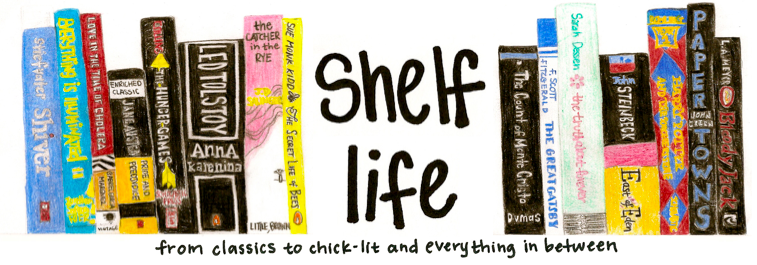★★☆☆☆
Two Things I Liked About Where She Went:
1. All-night private tour of NYC.
2. Intense impromptu cello/guitar duet.
Can we just start with a collective “ugh!” for the cover? UGH! Who approved this? It’s an eyesore! I really despise when publishers put actual human faces on covers. Drawings: okay. Profiles: if you must. Faces: abort!
Where She Went is the sequel to a novel that came out last spring and made waves on the young adult circuit, called If I Stay. If I Stay is part love story (romantic, of course, but also familial and musical) and part tragedy. In the aftermath of a car crash that kills her parents and younger brother, Mia – comatose and barely stable in the ICU, while her spirit somehow (it’s fiction, after all) roams the hospital, observing the chaos of grief for her family and fierce hope for herself amongst her remaining loved ones, including her boyfriend, Adam – is faced with the ultimate decision: should she let go, or should she stay? The story is wrenching, but it is also beautiful and moving. I read it in one sitting, tucked into the backseat of a car speeding along the autobahn in the dark, with the melancholy melodies of classical music (fitting, as music is a powerful theme in If I Stay, Mia being a Juilliard-bound cellist) sealing me into my own little bubble of story and sound, which only made it all the easier to be swept up by the emotional currents of the novel.
Not so Where She Went. I will allow that the fact that I couldn’t read it in one sitting may have impeded some of the story’s emotional momentum, but I don’t think that can be held wholly, or even mostly, responsible. Where If I Stay was a deeply felt tale of love, loss, and the ties that bid (to each other, to life), with a cast of characters, a plot, and a point of view that were refreshingly and captivating original in a genre prone to cliché, Where She Went made up for that originality in spades by conforming to clichés of the genre, the characters becoming nearly unrecognizable for the generic corruption wreaked on them. If If I Stay was as piercing and individual as a personal experience of loss, as hauntingly beautiful and melancholy as a cello solo, then Where She Went is the Hallmark card you receive from your coworker a week after the funeral.
Where She Went shifts from Mia’s point of view to her boyfriend – now ex-boyfriend – Adam’s. If I Stay explored the onset of Mia’s loss, and Where She Went explores the ongoing burden of Adam’s. Not only did he also lose Mia’s family – who had accepted into their fold – but a few months later, he lost Mia as well, when she left for Juilliard and inexplicably stopped communicating. He turned his compounded hurt and confusion into music, writing an entire album in 2 weeks, an album that gets him and his band, Shooting Star, signed and chart topping in a matter of a few whirlwind months. Now, 3 years later, he’s a bona fide rock-star with a celebrity girlfriend, constant attention from the paparazzi, a world tour – and a new smoking habit, anxiety meds, and a falling out with his band mates to show for it. He may have millions in the bank and thousands in the audience, but he’s a sad, lonely, and strung-out soul who can’t remember what he loves about the only thing he used to care about as much as Mia.
Then the night before Adam flies to London to kick off a 67-show world tour, when his manager gives him a night off to pull himself back together (he’s on the verge of a mental and ideological breakdown), he stumbles on a poster outside Carnegie Hall, advertising a concert that evening for a promising young cellist – who is, of course, none other than Mia. After the concert, Mia has him called backstage, and thus begins a night spent touring Mia’s New York and tending to old flames – to be extinguished or rekindled, depending on what the night brings.
I had a few deal-breaking issues with this book. The biggest is that I really wish Gayle hadn’t made Adam and Mia such rock-stars. This book would have been exponentially better if Shooting Star had retained its relatively anonymous indie status, and Mia was just an above average but not headlining Juilliard student. One of the fabulous things about If I Stay was the normality of the characters and their lives. The story was so affective because the characters involved weren’t so much different than you. The moment Gayle decided to make Adam a rock-star and Mia a renowned cellist, she axed that accessibility. I just couldn’t really relate as well to them anymore, especially to Adam, who spent a significant chunk of the novel hiding and running from fans, whining about his impending world tour and clingy celebrity girlfriend, and losing his temper with paparazzi.
Other qualms: The lyrics at the start of each chapter, supposedly from Adam’s career-launching record, were melodramatic and cheesy; I wish more of the novel had been spent in the present, rather than switching back and forth every other chapter to the past; Mia needed a stronger presence, because even though the novel was told from Adam’s point of view, it felt entirely too Adam-centric, compared to If I Stay, which gave a rounded portrayal of Adam even though it was told through Mia’s lens.
All things considered, I’m not sure I would even recommend Where She Went to fans of If I Stay. I felt more satisfied by the open end of If I Stay than I did by the resolution of Where She Went.
Books Read This Year: 34
Top 100 Progress: 42/100


No comments:
Post a Comment